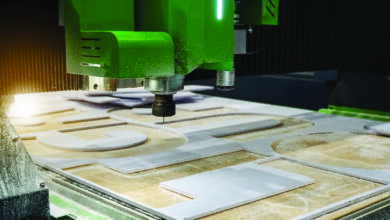Learning how to customize and configure a CNC router for the first time can be a time-consuming and confusing process. Fabricating parts with rough edges is a common issue for the novice. Workarounds or make-shift solutions can work temporarily, but what about in the long run? A reputable CNC manufacturer will help, especially if they provide training as part of their services.
In the meantime, familiarize yourself with all things CNC-related. When you’re all set to go, consider these four tips for successful CNC routing.
1. File design
Understanding how to design a part plays into how successful you are at meeting the right expectations for the job. As CNC machines vary in options and configurations, it’s important to ask how easy it is to modify the CAD file to suit the technology available in-house. A small modification has the potential to massively improve your cost-per-part and positively impact quality and lead times.
2. Tooling selection
Choosing the right tooling for a job is equally as important as verifying the design of the part. If you’ve been processing the same material for many years, you might need to explore the possibility of processing new materials, especially if you want to price things competitively. Woodworkers with CNC machines are often asked to process materials such as aluminum or acrylic for customer-specific applications where combinations of materials are used. By re-tooling, you can fabricate additional materials using in-house equipment — offering additional sources of revenue and a path for the consolidation of vendors for your customers.
3. Set up the right machining parameters for the job
How a tool behaves across different materials as well as machining operations will have an impact on speeds used and quality achieved. It’s integral that you understand how to use the right chip-load based on the manufacturer’s recommendations or by self-calculating the proper cutting parameters for that specific material, grade, or operation. Similarly, selecting the right direction for the cut (forward or reverse) will impact the quality of your part.
4. Maximizing throughput
Effective CNC routing requires the workpiece to be solidly held down to reduce unwanted vibrations and to safely secure parts given the high speeds and loads exerted by the cutting spindle. Additionally, the use of industrial dust collection systems and cooling methods such as compressed air or minimum quantity lubrication (MQL) systems for non-ferrous metal routing can all positively improve cut speeds, quality, and lower costs. A good dust collection system will reduce the downtime required for maintenance and can also improve your cut quality by reducing the material wedges in the cutting area as well as lowering the chances for rewelding (i.e., acrylic routing).




